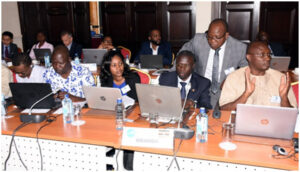State of the Economy



Over the last two and half decades, Uganda economy has experienced a strong and consistent growth—at an average of about 5 percent per annum—(Figure 1), and there are several avenues of enhancing this growth under the AfCFTA in all the three economic sectors—agriculture, industry and services sectors.
Uganda relies on services for growth and agriculture sector for exports. The Services sector remains the largest contributor to GDP (at 41.5 percent in 2021/2022), followed by Industry at 26.8 percent; and Agriculture, Forestry, and Fishing sector at 24.1 percent. However, the value added to national income by each of these sectors is still concentrated in a few subsectors.For example, over 65 percent of the share of the overall output in the Services sector is accounted for by only six subsectors—trade and repairs, real estate, education, health, financial and insurance services, and transportation and storage. The five broad service sectors that are prioritized in the AfCFTA negotiations on trade in services—for liberalization (Table 2.1)—Business services, communication services, financial services, tourism services, and transport services accounted for 63.9 percent of the overall output in the Services sector and 26.4 percent of Uganda’s GDP in 2021/22. Opening up these sectors to foreign competition under the AfCFTAarrangement may attract investment, innovation, and increase productivity, and potentially accelerate expansion of these sectors in commercial areas that benefit the wider economy and increase the participation of SMEs, women and the youth in Services value chains.
A simple decomposition of the underlying components of economic growth indicates that most of the increases in national income stem from the Services sector, which grew by a record 17 fold between 2000/01 and 2021/22. The key drivers of growth in Services have been business services (trade and repairs, and real estate activities) and education services, which combined, accounted for 56.2 percent of services growth and 20.7 percent of the GDP growthin 2018/19. These growth episodes have been facilitated by income-related demand shifts and growth in information and communication technology as well as the growing importance of basic infrastructural services, including communication and financial services.
While Uganda merchandise exports has increased consistently over the last four decades, from US$ 0.196 billion in 1991 to US$ 0.8863 billion in 2004/05, reaching US$1.0425 billion in 2005/06 and US$2.95187 in 2021/22 (representing 11 percent of GDP and 0.008 percent of world exports in 2022), Uganda still relies heavily on the production and export of a few commodities with minimal value addition and even fewer forward and backward linkages with other sectors of the economy.




